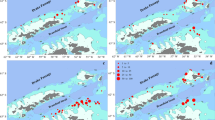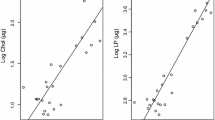Abstract
We studied the abundance, length-frequency distribution and body composition (lipid accumulation) of the ctenophore Mertensia ovum in Kongsfjorden, Svalbard (79°N) between May 2001 and April 2002. The highest abundances were found during summer in the outer and middle areas of the fjord, possibly caused by the concentration of advected zooplankton. Polymodal length-frequencies indicated a life span of 2 years, with 0, 1 and 2-groups being present in summer. Total lipid for a standardized animal decreased from May to August, and increased to the highest level in September. Relative lipid content was always highest in the 0-group, probably reflecting reduction of lipid levels due to increased energy costs during reproduction for the older age groups. Lipids probably are used to fuel prolonged reproduction from May to August until spawning ends by September. The overwintering age groups (0 and 1) subsequently build up lipid reserves for the next years’ spawning.






Similar content being viewed by others
References
Basedow SL, Eiane K, Tverberg V, Spindler M (2004) Advection of zooplankton in an Arctic fjord (Kongsfjorden, Svalbard). Estuar Coast Shelf Sci 60:113–124
Clarke A (1980) A reappraisal of the concept of metabolic cold adaptation in polar marine invertebrates. Biol J Linn Soc 14:77–92
Cottier F, Tverberg V, Inall M, Svendsen H, Nilsen F, Griffiths C (2005) Water mass modification in an Arctic fjord through cross-shelf exchange: the seasonal hydrography of Kongsfjorden, Svalbard. J Geophys Res 110:C12005. DOI 10.1029/2004JC002747
Deason EE, Smayda TJ (1982) Ctenophore-zooplankton–phytoplankton interactions in Narragansett Bay, Rhode-Island, USA, during 1972–1977. J Plankton Res 4:203–217
Falkenhaug T, Nordby E, Svendsen H, Tande K (1995) Impact of advective processes on displacement of zooplankton biomass in a North Norwegian fjord system: a comparison between spring and autumn. In: Skjoldal HR, Hopkins C, Erikstad KE, Leinaas HP (eds) Ecology of fjords and coastal waters. Elsevier, Amsterdam, pp 195–217
Falk-Petersen S (1985) Growth of the euphausiids Thysanoessa inermis, Thysanoessa raschii, and Meganyctiphanes norvegica in a subarctic fjord, North Norway. Can J Fish Aquat Sci 42:14–22
Falk-Petersen S, Sargent JR, Tande KS (1987) Lipid composition of zooplankton in relation to the sub-Arctic food web. Polar Biol 8:115–120
Falk-Petersen S, Pedersen G, Kwasniewski S, Hegseth EN, Hop H (1999) Spatial distribution and life-cycle timing of zooplankton in the marginal ice zone of the Barents Sea during the summer melt season in 1995. J Plankton Res 21:1249–1264
Falk-Petersen S, Dahl TM, Scott CL, Sargent JR, Gulliksen B, Kwasniewski S, Hop H, Millar R-M (2002) Lipid biomarkers and trophic linkages between ctenophores and copepods in Svalbard waters. Mar Ecol Prog Ser 227:187–194
Folch J, Lees M, Stanley GHS (1957) A simple method for the isolation and purification of total lipides from animal tissues. J Biol Chem 226:497–509
Gannefors C, Böer M, Kattner G, Graeve M, Eiane K, Gulliksen B, Hop H, Falk-Petersen S (2005) The Arctic sea butterfly Limacina helicina: lipids and life strategy. Mar Biol 147:169–177
Graham WM, Pages F, Hamner WM (2001) A physical context for gelatinous zooplankton aggregations: a review. Hydrobiologia 451:199–212
Greve W (1970) Cultivation experiments on North Sea ctenophores. Helgoländer Wissenschaftliche Meeresuntersuchungen 20:304–317
Hagen W, Schnack-Schiel SB (1996) Seasonal lipid dynamics in dominant Antarctic copepods: energy for overwintering or reproduction? Deep-sea research part I. Oceanogr Res Pap 43:139–158
Hamner WM, Madin LP, Alldredge AL, Gilmer RW, Hamner PP (1975) Underwater observations of gelatinous zooplankton—sampling problems, feeding biology, and behavior. Limnol Oceanogr 20:907–917
Harrison NM (1984) Predation on jellyfish and their associates by seabirds. Limnol Oceanogr 29:1335–1337
Hirota J (1974) Quantitative natural history of Pleurobrachia bachei in La-Jolla Bight. Fish Bull 72:295–235
Hoeger U (1983) Biochemical composition of ctenophores. J Exp Mar Biol Ecol 72:251–261
Hop H, Pearson T, Hegseth EN, Kovacs KM, Wiencke C, Kwasniewski S, Eiane K, Mehlum F, Gulliksen B, Wlodarska-Kowalzuk M, Lydersen C, Weslawski JM, Cochrane S, Gabrielsen GW, Leakey RJG, Lønne OJ, Zajaczkowski M, Falk-Petersen S, Kendall M, Wängberg S-Å, Bischof K, Voronkov AY, Kovaltchouk NA, Wiktor J, Poltermann M, di Prisco G, Papucci C, Gerland S (2002) The marine ecosystem of Kongsfjorden, Svalbard. Polar Res 21:167–208
Ingvaldsen R, Bø Reitan M, Svendsen H, Asplin L (2001) The upper layer circulation in Kongsfjorden and Krossfjorden—a complex fjord system on the west coast of Spitsbergen. Mem Natl Inst Polar Res 54(special issue):393–407
Kwasniewski S, Hop H, Falk-Petersen S, Pedersen G (2003) Distribution of Calanus species in Kongsfjorden, a glacial fjord in Svalbard. J Plankton Res 25:1–20
Larson RJ (1986) Seasonal changes in the standing stocks, growth rates, and production rates of gelatinous predators in Saanich Inlet, British-Columbia. Mar Ecol Prog Ser 33:89–98
Larson RJ, Harbison GR (1989) Source and fate of lipids in polar gelatinous zooplankton. Arctic 42:339–346
Macdonald PDM, Pitcher TJ (1979) Age-groups from size-frequency data—versatile and efficient method of analyzing distribution mixtures. J Fish Res Board Can 36:987–1001
Mills CE (1984) Density is altered in hydromedusae and ctenophores in response to changes in salinity. Biol Bull 166:206–215
Mortensen T (1912) Ctenophora. In: Hagerup H (ed) The Danish Ingolf expedition. Copenhagen, pp 1–95
Omori M, Hamner WM (1982) Patchy distribution of zooplankton—behavior, population assessment and sampling problems. Mar Biol 72:193–200
Percy JA (1989) Abundance, biomass, and size frequency distribution of an Arctic ctenophore, Mertensia ovum (Fabricius) from Frobisher Bay, Canada. Sarsia 74:95–105
Percy JA, Fife FJ (1981) The biochemical composition and energy content of arctic marine macrozooplankton. Arctic 34:307–313
Percy JA, Fife FJ (1985) Energy distribution in an arctic coastal macrozooplankton community. Arctic 38:39–42
Pianka H (1974) Ctenophora. In: Giese A, Pearse J (eds) Reproduction of marine invertebrates. Academic, New York, pp 201–265
Purcell JE (1991) A review of cnidarians and ctenophores feeding on competitors in the plankton. Hydrobiologia 216:335–342
Raskoff KA, Purcell JE, Hopcroft RR (2005) Gelatinous zooplankton of the Arctic Ocean: in situ observations under the ice. Polar Biol 28:207–217
Reeve MR, Walter MA (1978) Nutritional ecology of ctenophores—a review of recent research. Adv Mar Biol 15:249–287
Reeve MR, Walter MA, Ikeda T (1978) Laboratory studies of ingestion and food utilization in lobate and tentaculate ctenophores. Limnol Oceanogr 23:740–751
Schneider G (1987) Role of advection in the distribution and abundance of Pleurobrachia pileus in Kiel Bight. Mar Ecol Prog Ser 41:99–102
Scott CL, Kwasniewski S, Falk-Petersen S, Sargent JR (2000) Lipids and life strategies of Calanus finmarchicus, Calanus glacialis and Calanus hyperboreus in late autumn, Kongsfjorden, Svalbard. Polar Biol 23:510–516
Siferd TD, Conover RJ (1992) Natural history of ctenophores in the Resolute Passage area of the Canadian High Arctic with special reference to Mertensia ovum. Mar Ecol Prog Ser 86:133–144
Søreide JE, Hop H, Falk-Petersen S, Gulliksen B, Hansen E (2003) Macrozooplankton communities and environmental variables in the Barents Sea marginal ice zone in late winter and spring. Mar Ecol Prog Ser 263:43–64
Stoecker DK, Verity PG, Michaels AE, Davis LH (1987) Feeding by larval and postlarval ctenophores on microzooplankton. J Plankton Res 9:667–683
Svendsen H, Beszczynska-Møller A, Hagen JO, Lefauconnier B, Tverberg V, Gerland S, Ørbæk JB, Bischof K, Papucci C, Zajaczkowski M, Azzolini R, Bruland O, Wiencke C, Winther J-G, Dallmann W (2002) The physical environment of Kongsfjorden-Krossfjorden, an Arctic fjord system in Svalbard. Polar Res 21:133–166
Swanberg N, Båmstedt U (1991) Ctenophora in the Arctic—the abundance, distribution and predatory impact of the cydippid ctenophore Mertensia ovum (Fabricius) in the Barents Sea. Polar Res 10:507–524
Venables W, Ripley B (2002) Modern applied statistics with S. Springer, Berlin Heidelberg New York
Venables W, Smith D, Team RDC (2002) An introduction to R. Network Theory Limited, Bristol
Walkusz W, Storemark K, Skau T, Gannefors C, Lundberg M (2003) Zooplankton community structure; a comparison of fjords, open water and ice stations in the Svalbard area. Pol Polar Res 24:149–165
Acknowledgements
We thank the captains and crews of RVs Lance, Oceania and Håkon Mosby for help with sampling and Tone Falkenhaug for helpful comments to an earlier draft of this paper. Thanks to Frank Beuchel for MIX analysis of the length-frequency data and Jan Roald (Norwegian Polar Institute) for the illustration of M. ovum. Grants to Marte Lundberg were provided by “Roald Amundsens senter for Arktisk Forskning”, “Arktis stipend” (Norwegian Polar Institute), “Haakon den 7des utdannelsesfond for norsk ungdom” (Univ. Tromsø), “Kometen stipend” (Univ. Tromsø), “Kellfrid og Helge Jakobsens fond”, “Lise og Arnfinn Hejes fond”, “Stiftelsen Thomas Fearnley, Heddy og Nils Astrup” and “Sandvika Rotary”.
Author information
Authors and Affiliations
Corresponding author
Additional information
Communicated by M. Kühl, Helsingor
Rights and permissions
About this article
Cite this article
Lundberg, M., Hop, H., Eiane, K. et al. Population structure and accumulation of lipids in the ctenophore Mertensia ovum . Mar Biol 149, 1345–1353 (2006). https://doi.org/10.1007/s00227-006-0283-7
Received:
Accepted:
Published:
Issue Date:
DOI: https://doi.org/10.1007/s00227-006-0283-7




